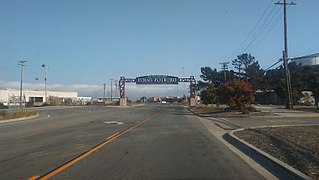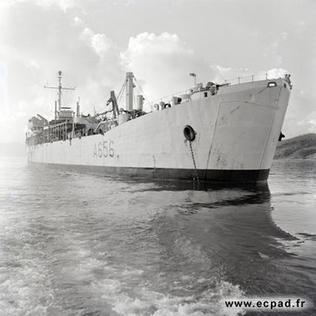This page is based on this
Wikipedia article Text is available under the
CC BY-SA 4.0 license; additional terms may apply.
Images, videos and audio are available under their respective licenses.

The USS Richmond was a wooden steam sloop in the United States Navy during the American Civil War.

SS Red Oak Victory is a U.S. military Victory ship of the Boulder Victory-class cargo ship used in the Second World War. She was preserved to serve as a museum ship in Richmond, California, and is part of the Rosie the Riveter/World War II Home Front National Historical Park. She was one of 534 Victories built during World War II, but one of only a few of these ships to be transferred from the Merchant Marine to the United States Navy. She was named after Red Oak, Iowa, which suffered a disproportionate number of casualties in early World War II battles.. The ship was active during World War II, the Korean War, and the Vietnam War.

The Kaiser Shipyards were seven major shipbuilding yards located on the United States west coast during World War II. Kaiser ranked 20th among U.S. corporations in the value of wartime production contracts. The shipyards were owned by the Kaiser Shipbuilding Company, a creation of American industrialist Henry J. Kaiser (1882–1967), who established the shipbuilding company around 1939 in order to help meet the construction goals set by the United States Maritime Commission for merchant shipping.
SS Henry R. Schoolcraft was a Liberty ship built in the United States during World War II.

The four Richmond Shipyards, located in the city of Richmond, California, United States, were run by Permanente Metals and part of the Kaiser Shipyards. During World War II, Richmond built more ships than any other shipyard, turning out as many as three ships in a single day. The shipyards are part of the Rosie the Riveter/World War II Home Front National Historical Park, whose the Rosie the Riveter memorial sits on the former grounds of Shipyard #2. Shipyard #3 is listed on the National Register of Historic Places.

USS LST-483/Brewster County (LST-483) was an LST-1-class tank landing ship built for the United States Navy during World War II. Later renamed for Brewster County, Texas, she was the only US Naval vessel to bear the name.

USS Agenor (ARL-3) was one of 39 Achelous-class repair ship landing craft repair ships built for the United States Navy during World War II. Named for Agenor, she was the only U.S. Naval vessel to bear the name.

The Emergency Shipbuilding Program was a United States government effort to quickly build simple cargo ships to carry troops and material to allies and foreign theatres during World War II. Run by the U.S. Maritime Commission, the program built almost 6,000 ships.
USS General C. C. Ballou (AP-157) was a General G. O. Squier-class transport ship for the U.S. Navy in World War II. She was named in honor of U.S. Army general Charles Clarendon Ballou. She was transferred to the U.S. Army as USAT General C. C. Ballou in 1946. On 1 March 1950, she was transferred to the Military Sea Transportation Service (MSTS) as USNS General C. C. Ballou (T-AP-157). She was later sold for commercial operation under several names before being scrapped some time after 1981.

USNS Sgt. Curtis F. Shoup (T-AG-175) was a C1-M-AV1 coastal freighter. Built as Spindle Eye, one of the many named for knots. The ship, modified to be a "news transmission ship" for the press during the planned invasion of Japan, was completed 9 July 1945, delivered to the War Shipping Administration and placed under its agent Lykes Brothers Steamship Company the same day. Days later, on 26 July, Spindle Eye was bareboat chartered to the War Department for operation by the Army. The ship was renamed November 1947 by the Army, after serving as a radio relay ship at the Operation Crossroads atomic bomb tests and conversion to an Army passenger-cargo vessel, Sgt. Curtis F. Shoup in honor Sergeant Curtis F. Shoup who had been awarded the Medal of Honor.

The Ocean ships were a class of sixty cargo ships built in the United States by Todd Shipyards Corporation during the Second World War for the British Ministry of War Transport under contracts let by the British Purchasing Commission. Eighteen were lost to enemy action and eight to accidents; survivors were sold postwar into merchant service.

USS LST-477/LST(H)-477 was a United States Navy LST-1-class tank landing ship used in the Asiatic-Pacific Theater during World War II.

USS LST-479 was a United States Navy LST-1-class tank landing ship used in the Asiatic-Pacific Theater during World War II.

USS LST-479 was a United States Navy LST-1-class tank landing ship used in the Asiatic-Pacific Theater during World War II.

USS LST/LST(H)-486 was an LST-1-class tank landing ship built for the United States Navy during World War II.















